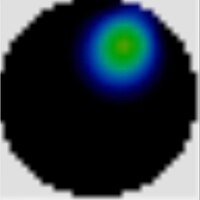Electrical capacitance tomography

Imagine you have a bunch of different colored candy inside a big jar, but you can't see through the jar to figure out how many of each color there are. Electrical capacitance tomography (ECT) is a way to "see" inside the jar without opening it, by using electricity instead of light.
ECT works by sending small electrical signals into the jar through special electrodes placed on the outside. These signals create a pattern of electric fields inside the jar, which bump into the candies and change the field. Different types of candy will change the field in different ways, depending on their size, shape, and position in the jar.
The ECT system then measures these changes and creates a picture or "tomogram" of the candies inside the jar. It's like taking an X-ray or CT scan of the jar, but using electricity instead of radiation.
In the real world, ECT is used in industry to "see" inside pipes, tanks, and reactors that are filled with materials such as powders, liquids, or gas. By using ECT, engineers and scientists can monitor processes or detect problems such as blockages or leaks, without having to shut down the system or break it open.
So, the next time you see a jar full of candy, remember that ECT can help you "see" what's inside without even touching it!
ECT works by sending small electrical signals into the jar through special electrodes placed on the outside. These signals create a pattern of electric fields inside the jar, which bump into the candies and change the field. Different types of candy will change the field in different ways, depending on their size, shape, and position in the jar.
The ECT system then measures these changes and creates a picture or "tomogram" of the candies inside the jar. It's like taking an X-ray or CT scan of the jar, but using electricity instead of radiation.
In the real world, ECT is used in industry to "see" inside pipes, tanks, and reactors that are filled with materials such as powders, liquids, or gas. By using ECT, engineers and scientists can monitor processes or detect problems such as blockages or leaks, without having to shut down the system or break it open.
So, the next time you see a jar full of candy, remember that ECT can help you "see" what's inside without even touching it!
Related topics others have asked about:
